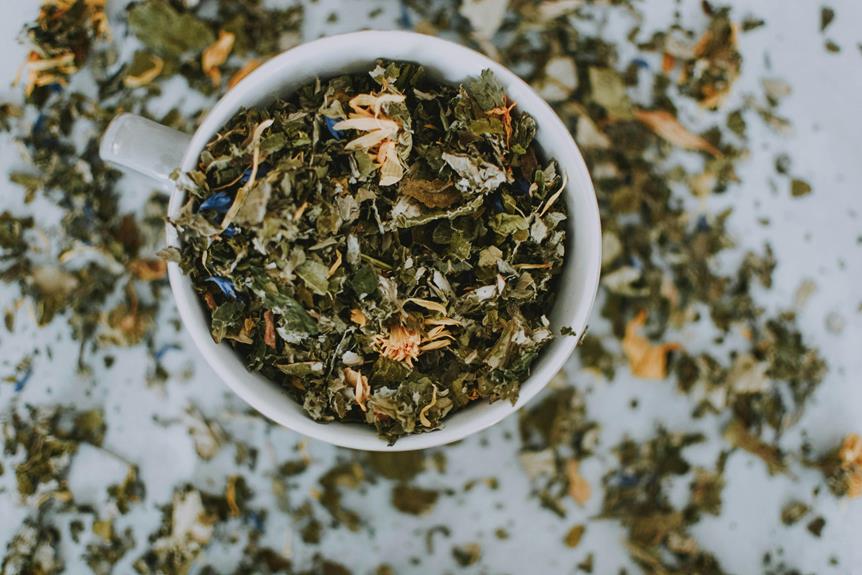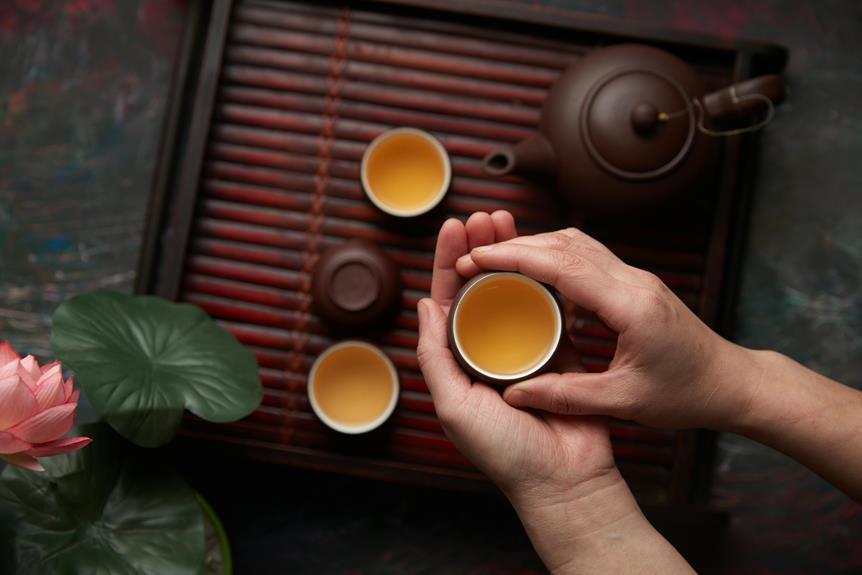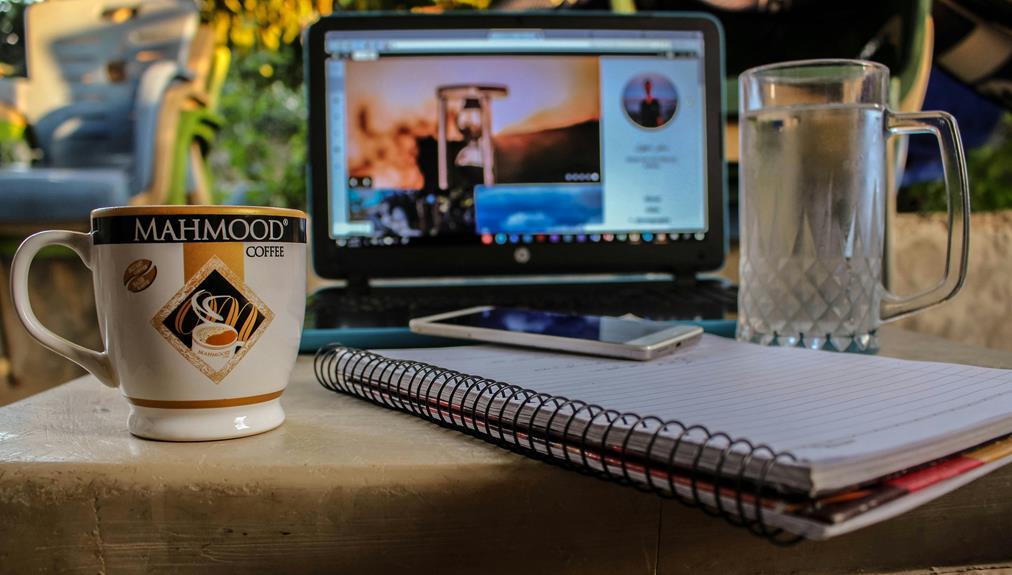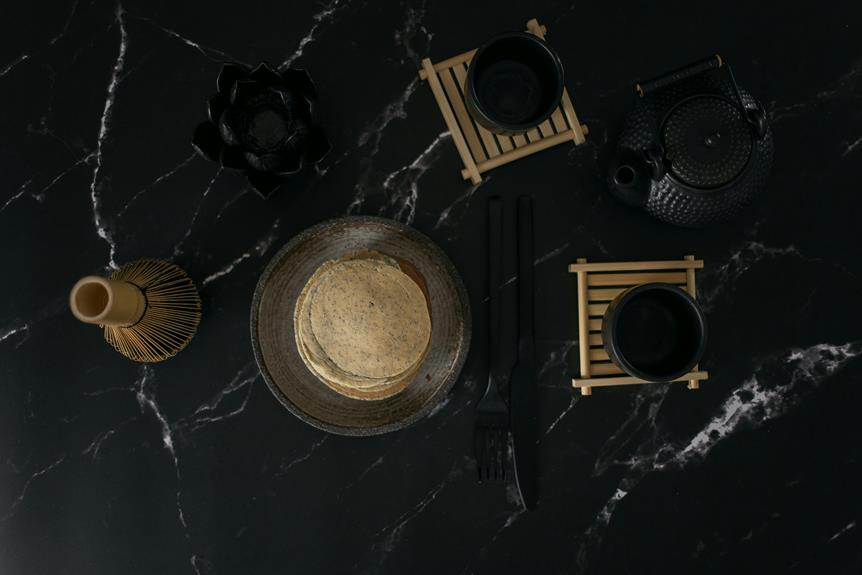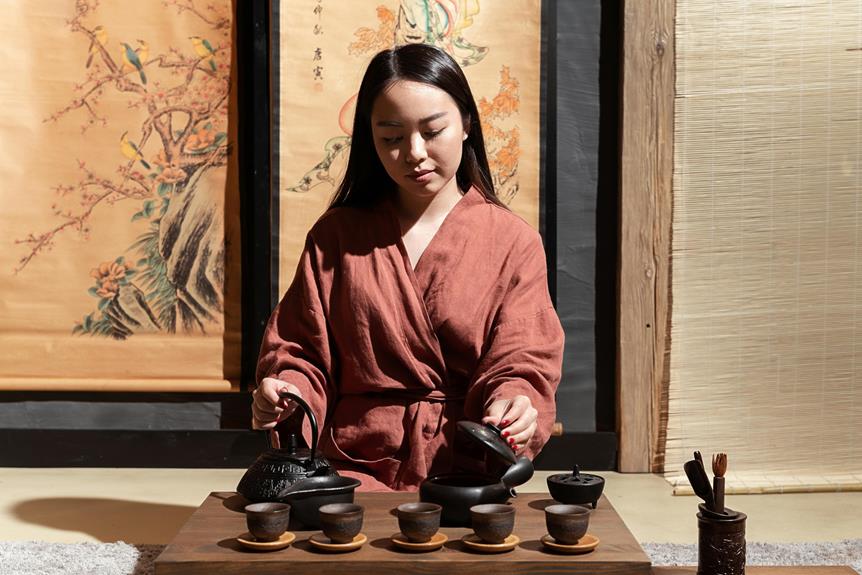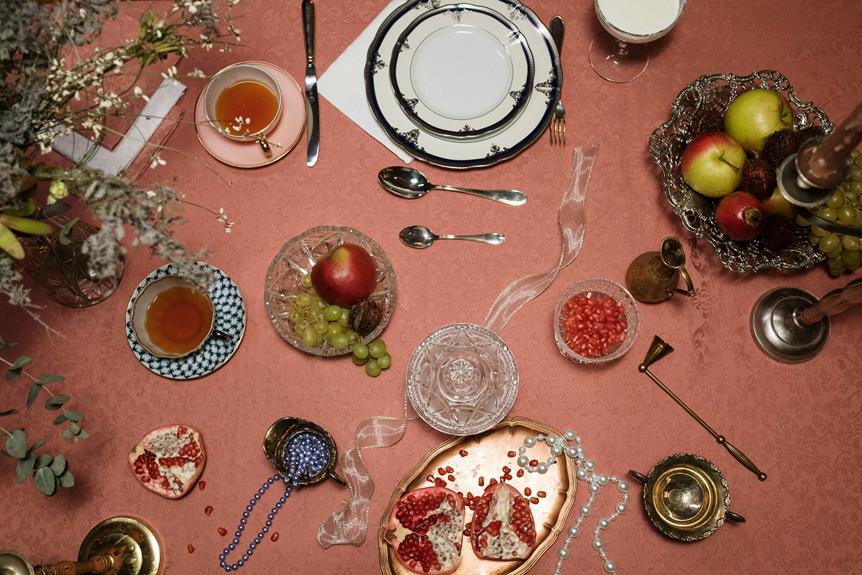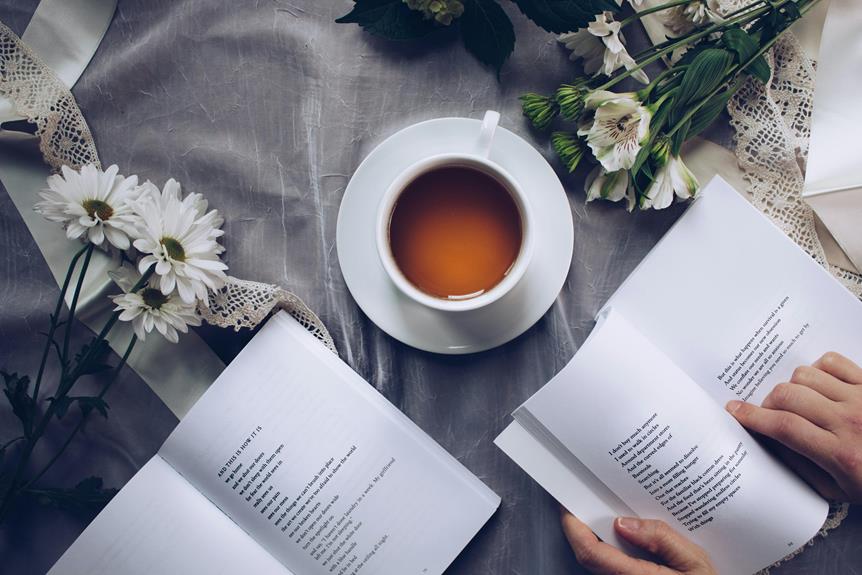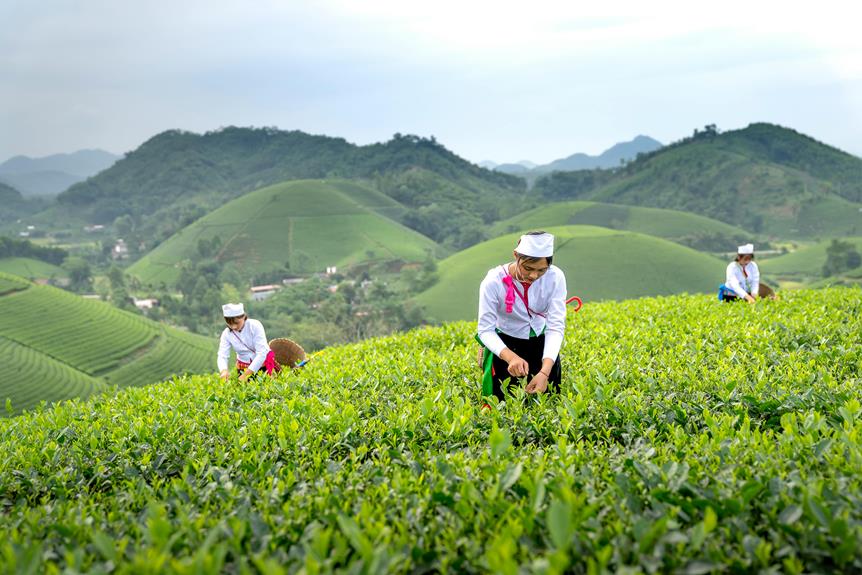To properly steep herbal teas for the best taste and benefits, start by choosing the right herb for your taste preferences and health goals. Understand that different herbs require unique steeping times, with delicate herbs like chamomile needing 5-7 minutes and robust herbs like peppermint requiring 8-10 minutes. Water temperature matters too, with most herbs thriving between 160°F and 190°F. Use the right herb-to-water ratio, typically one teaspoon of loose-leaf herbs or one tea bag for every 8 oz of water. By following these steps, you'll be well on your way to releasing the full flavor and benefits of your herbal tea – and there's still more to discover.
Key Takeaways
- Understand the optimal steeping time for each herbal tea, as delicate herbs like chamomile require 5-7 minutes, while robust herbs like peppermint need 8-10 minutes.
- Use the right water temperature, ranging from 150°F to 190°F, to avoid thermal shock and bring out the best flavor and benefits.
- Measure the herb-to-water ratio accurately, using one teaspoon of loose-leaf herbs or one herbal tea bag for every 8 oz of water, to achieve the perfect balance.
- Handle delicate herbs with care, avoiding crushing or bruising, and store them in a cool, dark place to preserve their natural oils and flavor.
- Experiment with different steeping times, temperatures, and ratios to find the ideal combination that suits your taste preferences and health goals.
Choosing the Right Herbal Tea
You'll find over 1,000 herbal teas on the market, each with its unique flavor profile, aroma, and potential health benefits.
When choosing the right one for you, consider your personal taste preferences and health goals. Do you prefer sweet and fruity or earthy and spicy? Look for herbal teas with flavor profiles that match your taste buds.
For instance, peppermint and chamomile teas are calming and soothing, while ginger and turmeric teas are invigorating and anti-inflammatory.
Seasonal options are also worth exploring.
In the winter, try teas with warming spices like cinnamon and cloves to combat the cold.
In the summer, opt for cooling teas with fruits like berries and citrus.
You can also experiment with herbal blends that combine different ingredients for a unique flavor experience.
Don't be afraid to try new teas and flavor profiles until you find the one that suits you best.
Understanding Steeping Times
Within minutes of adding hot water to your herbal tea, the magic begins, and the steeping process releases the flavors, aromas, and nutrients that make each blend unique.
As you wait for the perfect cup, you're probably wondering how long to let it steep. The answer lies in understanding the steep timing variations.
Different herbal teas require different steeping times to bring out their herbal nuances.
Delicate herbs like chamomile and lemon balm need a shorter steeping time of 5-7 minutes to prevent bitterness.
Meanwhile, robust herbs like peppermint and ginger can handle a longer steeping time of 8-10 minutes to release their full flavor.
Some herbal teas, like rosehip and hibiscus, benefit from a longer steeping time of 10-15 minutes to extract their nutrients and flavors.
Water Temperature Matters
The ideal water temperature for steeping herbal teas varies depending on the type of herb, with some requiring boiling water while others prefer a lower heat to avoid scorching their delicate flavors.
You'll want to avoid Thermal Shock, which occurs when you expose herbs to water that's too hot, causing them to lose their flavor and nutritional benefits.
For most herbal teas, a temperature between 160°F and 190°F is ideal. However, some herbs like peppermint and chamomile require boiling water, around 212°F, to release their full flavor potential.
On the other hand, delicate herbs like rose petals and lemon balm prefer a lower temperature, around 150°F, to prevent scorching.
When brewing herbal teas, make sure to bring the water to the recommended temperature, then let it cool for a minute or two before pouring it over the herbs.
This will guarantee you're getting the best flavor and benefits from your tea. Remember, the Boiling Point of water is just a starting point, and you should adjust the temperature based on the specific herb you're using.
Herb to Water Ratio
Your herb to water ratio is essential, as it directly impacts the flavor, aroma, and potency of your herbal tea. The right balance achieves you get the most out of your tea leaves.
A general rule of thumb is to use one teaspoon of loose-leaf herbs or one herbal tea bag for every 8 oz of water. However, this can vary depending on the type of herb, personal preference, and desired strength.
To get it just right, it's vital to use accurate measurement tools, such as a digital scale or measuring spoons. This will guarantee the perfect ratio every time, which is especially important if you're brewing a blend of herbs.
Remember, the freshness impact of your herbs also plays a role in the ratio. Fresh herbs typically require less water than dried ones, so adjust accordingly.
Experiment with different ratios to find your ideal balance. Don't be afraid to adjust the amount of herbs or water to suit your taste preferences. By mastering the herb to water ratio, you'll release the full potential of your herbal tea and enjoy a more flavorful, aromatic, and potent brew.
Delicate Herbs Require Care
When working with delicate herbs like chamomile or lemon balm, you'll need to take extra care to prevent them from becoming bitter or losing their flavor. These herbs are more prone to damage, so gentle handling is a must to preserve their delicate flavor and aroma.
One key aspect is your handling techniques. Avoid crushing or bruising the leaves, as this can release unwanted compounds that affect the taste. Instead, use a light touch when measuring out the herbs, and avoid exposing them to direct sunlight or heat.
Proper storage methods are also imperative. Keep delicate herbs in a cool, dark place, away from moisture and strong-smelling spices. Use airtight containers to prevent contamination and preserve the herbs' natural oils.
Robust Herbs Need Time
Five to seven minutes is the minimum steeping time you'll need to coax out the full flavor and benefits of robust herbs like peppermint, ginger, and rosemary. These herbs have complex herbal nuances that require a longer steeping time to release their potential.
As you steep, you're allowing the flavors and active compounds to meld together, resulting in a more satisfying taste and aroma.
When working with robust herbs, you're conducting a root exploration, uncovering the depths of their flavor profiles and therapeutic properties.
Take peppermint, for instance, which can be quite pungent if not steeped long enough. Giving it the necessary time allows the menthol to mellow out, revealing a calming and soothing brew.
Similarly, ginger requires a longer steep to bring out its spicy warmth and digestive benefits.
The Importance of Patience
Steeping herbal teas requires patience, as rushing the process can result in a brew that's unbalanced or lacking in flavor and potency.
When you take the time to steep your tea properly, you're not just waiting for the flavors to meld together – you're creating an opportunity for mindful moments.
As you sit quietly, watching the leaves unfurl and the colors blend, you're giving yourself a chance to slow down and appreciate the simple things.
This quiet reflection can be incredibly therapeutic, helping to calm your mind and soothe your spirit.
By embracing the slow and gentle process of steeping herbal teas, you're not just making a drink – you're cultivating a sense of inner peace.
So take a deep breath, let go of your hurry, and let the tea do its magic.
Your patience will be rewarded with a brew that's not only delicious but also deeply nourishing.
Steeping for Optimal Benefits
To tap into the full potential of your herbal tea, you'll want to steep it for the ideal amount of time, as this allows the active compounds to dissolve into the liquid and release their medicinal properties.
This is where steeping techniques come into play. The right steeping technique can make all the difference in revealing the full benefits of your herbal tea.
For instance, delicate herbs like chamomile and lemon balm require a shorter steeping time to prevent bitterness, while heartier herbs like peppermint and ginger can handle longer steeping times.
Infusion methods also play a vital role in releasing the maximum amount of beneficial compounds.
Hot water infusion is ideal for releasing the active compounds in herbs like echinacea and ginkgo biloba, while cold-brew infusion is better suited for herbs like hibiscus and rosehips.
Experimenting With Blends
You can take your herbal tea game to the next level by crafting unique blends that cater to your personal preferences and health goals.
This is where the fun begins – experimenting with different herbs to create a flavor profile that resonates with you.
Start by selecting a few herbs that complement each other in respect to flavor, aroma, and benefits. For instance, you might combine peppermint's invigorating zing with the calming effects of chamomile.
As you explore different blends, pay attention to the aroma, noticing how the scents of each herb interact. This is Aroma Exploration 101!
Take notes on what you like and dislike, and adjust your blends accordingly. Don't be afraid to try new combinations – that's where the magic happens.
With each new blend, you'll refine your Flavor Profiling skills, discovering nuances and subtleties that elevate your herbal tea experience.
Frequently Asked Questions
Can I Reuse Herbal Tea Leaves for Multiple Infusions?
You're wondering if you can reuse herbal tea leaves for multiple infusions? While it's tempting, you'll sacrifice flavor and nutrients. Opt for a Cold Brew or create a mindful Tea Ritual with fresh leaves instead.
How Do I Store Herbal Teas to Preserve Their Flavor and Potency?
As a treasure hunter, you've uncovered a precious gem – herbal tea. To keep it shining, you store it in airtight containers, hidden away in cool places, protecting its flavor and potency from the thieves of light, heat, and moisture.
Are Herbal Teas Safe to Consume During Pregnancy or Breastfeeding?
You're wondering if herbal teas are safe during pregnancy or breastfeeding. Generally, they're okay, but some can pose pregnancy risks, like stimulating uterine contractions. However, others offer breastfeeding benefits, like supporting milk production and calming colic.
Can I Add Honey or Sugar to Herbal Tea Without Reducing Benefits?
"You're the master of your tea universe, and adding a sweetener is your call! You can sweeten your herbal tea with honey, sugar, or other options without reducing benefits, as long as you balance the flavor profiles to your taste."
Do Herbal Teas Expire, and How Can I Tell if They're Stale?
You're wondering if herbal teas expire, and the answer is yes! Check the packaging for expiration dates or shelf life, usually 6-12 months. If it's past that, the flavor and potency may dwindle, making it stale.
Conclusion
You've now mastered the art of steeping herbal teas!
Did you know that 80% of tea drinkers don't steep their tea long enough, missing out on the full flavor and benefits?
By following these simple guidelines, you'll access the perfect cup every time.
Experiment with different herbs, temperatures, and steeping times to find your new favorite blend.
